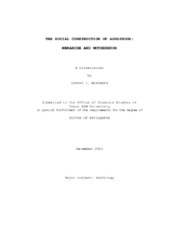| dc.description.abstract | Demographic and sociological theories usually do not incorporate biological variable into their explanations. This dissertation addresses this void by examining the influence of age at menarche on age at first birth, the event of a first birth, and the number of children ever born (CEB). I expand on Demographic Transition theory by incorporating biology as one of the effects of modernization that has an effect on reducing fertility. Age at menarche decreases as a society modernizes. I use data from the 1995 Survey of Family Growth, Cycle V for the U.S., and the 1997 China Survey of Population and Reproductive Health. I further stratify the data into five race/ethnic groups: Chinese Han, Chinese minorities, U.S. Non-Hispanic Whites, U.S. Non-Hispanic Blacks, and U.S. Hispanics of Mexican origin. I use four different statistical methods to model my dependent variables: Ordinary Least Squares Regression, Cox Proportional Hazard Analysis, Poisson Regression, and Negative Binominal Regression. My first major finding is that the younger a woman is when reaching menarche, the younger she will be when giving birth to her first child. Second, the younger a woman is when reaching menarche, the longer the duration to a first birth and the less likely she is to experience a first birth. These two results are consistent in all the groups I analyze. Third, the younger a woman when reaching menarche, the fewer children she will produce. The U.S. Mexican-Origin women are an exception in this final outcome. It is well known that as a society modernizes, age at menarche decreases. Analyses in my dissertation indicate that as women’s ages at menarche decrease, their ages at giving birth to the first child also decrease, but their chances of having a first birth also decrease and their waiting time for having the first birth increases. Also, fertility will decline as age at menarche declines. | en |


